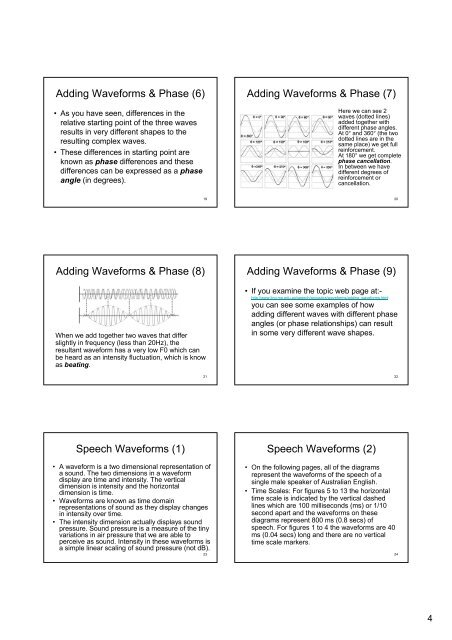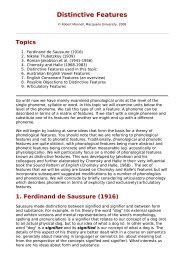Acoustic Waveforms Acoustic Waveforms Simple Harmonic Motion ...
Acoustic Waveforms Acoustic Waveforms Simple Harmonic Motion ...
Acoustic Waveforms Acoustic Waveforms Simple Harmonic Motion ...
You also want an ePaper? Increase the reach of your titles
YUMPU automatically turns print PDFs into web optimized ePapers that Google loves.
Adding <strong>Waveforms</strong> & Phase (6)<br />
• As you have seen, differences in the<br />
relative starting point of the three waves<br />
results in very different shapes to the<br />
resulting complex waves.<br />
• These differences in starting point are<br />
known as phase differences and these<br />
differences can be expressed as a phase<br />
angle (in degrees).<br />
Adding <strong>Waveforms</strong> & Phase (8)<br />
When we add together two waves that differ<br />
slightly in frequency (less than 20Hz), the<br />
resultant waveform has a very low F0 which can<br />
be heard as an intensity fluctuation, which is know<br />
as beating.<br />
Speech <strong>Waveforms</strong> (1)<br />
• A waveform is a two dimensional representation of<br />
a sound. The two dimensions in a waveform<br />
display are time and intensity. The vertical<br />
dimension is intensity and the horizontal<br />
dimension is time.<br />
• <strong>Waveforms</strong> are known as time domain<br />
representations of sound as they display changes<br />
in intensity over time.<br />
• The intensity dimension actually displays sound<br />
pressure. Sound pressure is a measure of the tiny<br />
variations in air pressure that we are able to<br />
perceive as sound. Intensity in these waveforms is<br />
a simple linear scaling of sound pressure (not dB).<br />
19<br />
21<br />
23<br />
Adding <strong>Waveforms</strong> & Phase (7)<br />
Here we can see 2<br />
waves (dotted lines)<br />
added together with<br />
different phase angles.<br />
At 0° and 360° (the two<br />
dotted lines are in the<br />
same place) we get full<br />
reinforcement.<br />
At 180° we get complete<br />
phase cancellation.<br />
In between we have<br />
different degrees of<br />
reinforcement or<br />
cancellation.<br />
Adding <strong>Waveforms</strong> & Phase (9)<br />
• If you examine the topic web page at:http://www.ling.mq.edu.au/speech/acoustics/waveforms/adding_waveforms.html<br />
you can see some examples of how<br />
adding different waves with different phase<br />
angles (or phase relationships) can result<br />
in some very different wave shapes.<br />
Speech <strong>Waveforms</strong> (2)<br />
• On the following pages, all of the diagrams<br />
represent the waveforms of the speech of a<br />
single male speaker of Australian English.<br />
• Time Scales: For figures 5 to 13 the horizontal<br />
time scale is indicated by the vertical dashed<br />
lines which are 100 milliseconds (ms) or 1/10<br />
second apart and the waveforms on these<br />
diagrams represent 800 ms (0.8 secs) of<br />
speech. For figures 1 to 4 the waveforms are 40<br />
ms (0.04 secs) long and there are no vertical<br />
time scale markers.<br />
20<br />
22<br />
24<br />
4
















